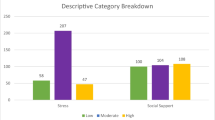Abstract
Although the word “mentor” has traditionally been used to describe a relationship between an older adult and a younger person, recent work has extended its usage to relationships with peers and groups rather than with individuals and uncoupled the instrumental and affective qualities of the role. This paper examines (a) the extent to which adolescents' relationships with significant others in different social roles are characterized by mentoring and (b) the extent to which mentoring and other relationship functions covary. Adolescents' naturally occurring social relationships are explored in two very different contexts—Japan and the United States—that differ in the norms and patterning of social interactions. College students (N = 365) used questionnaires to describe the extent to which relations with significant others were characterized by mentoring. Results indicate striking similarity in the patterning of results in the two countries and support the traditional view of mentoring. Mentoring is most likely to occur in relationships with adults (especially parents), rather than with peers, and with same-gender, rather than other-gender associates. Mentoring by parents appears to covary with other aspects of positive relationships, but be more independent in relationships with unrelated adults or peers. Although more of the variability in experienced mentoring is attributed to differences between associates than to differences between adolescents in both the United States and Japan, this is especially true of the United States. Results suggest that although “classic” mentoring is most common in both countries, mentoring is somewhat less constrained by social role differences in Japan than is in the United States.
Similar content being viewed by others
REFERENCES
Azuma, H. (1998). Japanese collectivism and education. In S. G. Paris & H. M. Wellman (Eds.), Global prospects for education: Development, culture, and schooling (pp. 291-307). Washington, DC: American Psychological Association.
Blyth, D., Hill, J. P., & Thiel, K. P. (1982). Early adolescents' significant others. Journal of Youth and Adolescence, 11, 425-250.
Bryk, A. S., & Raudenbusch, S. W. (1992). Hiearchical linear models: Applications and data analysis methods. Newbury Park, CA: Sage.
Darling, N., Hamilton, S. F., & Matsuda, S. (1990, March). Functional roles and social roles: Adolescents' significant others in the United States and Japan. Poster session presented at the meeting of the Society for Research in Adolescence, Atlanta, Georgia (ERIC Document Reproduction Service No. ED322453).
Darling, N., Hamilton, S. F., & Niego, S. (1994). Adolescents' relations with adults outside the family. In R. Montemayor, G. R. Adams, & T. P. Gullotta (Eds.), Advances in adolescent development: Adolescent close relationships (Vol. 6, pp. 216-235). Newbury Park,CA: Sage.
Eaton, W., & Bohrnstedt, G. (1989). Latent Variable models for Dichotomous outcomes: Introduction. Sociological Methods and Research, 18, 4-18.
Flaxman, E., Ascher, C., & Harrington, C. (1988). Youth mentoring: Programs and practices. New York: ERIC Clearinghouse on Urban Education.
Furman, W., & Buhrmester, D. (1992). Age and sex differences in perceptions of networks of personal relationships. Child Development, 63, 103-115.
Galbo, J. J. (1986). Adolescents' perceptions of significant adults: Implications for the family, the school, and youth serving agencies. Children and Youth Services Review, 8, 37-51.
Hamilton, S. F., & Darling, N. (1989). Mentors in adolescents' lives. In K. Hurrelmann & U. Engel (Eds.), The social world of adolescents. New York: DeGruyter.
Hamilton, S. F., & Hamilton, M. A. (1992). Mentoring programs: Promise and paradox. Phi Delta Kappan, 73, 546-550.
Hendry, L. B., Roberts, W., Glendinning, A., & Coleman, J. C. (1992). Adolescents' perceptions of significant individuals in their lives. Journal of Adolescence, 15, 255-270.
Hendry, L. B., Glendinning, A., & Shucksmith, J. (1996). Adolescent focal theories: Age trends in developmental transitions. Journal of Adolescence, 19, 307-320.
Hunter, F. (1984). Socializing procedures in parent-child and friendship relations during adolescence. Developmental Psychology, 18, 806-811.
Klaw, E., & Rhodes, J. E. (1995). Mentor relationships and the career development of pregnant and parenting African-American teenagers. Psychology of Women Quarterly, 19, 551-562.
Larson, R. (1994). Youth organizations, hobbies, and sports as developmental contexts. In R. K. Silbereisen & E. Tot (Eds.), Adolescence in context: The interplay of family, school, peers, and work in adjustment (pp. 46-65). New York: Springer.
Levinson, D. J. (1959). Role, personality, and social structure. Journal of Abnormal and Social Psychology, 58, 170-180.
Mislevy, R. (1986). Recent developments in the factor analysis of categorical variables. Journal of Education Statistics, 11, 3-31.
Philip, K., & Hendry, L. B. (1996). Young people and mentoring-towards a typology. Journal of Adolescence, 19, 189-201.
Rohlen, T. P. (1983). Japan's high schools. Berkeley, CA: University of California Press.
Schoggen, P. (1989). Behavior settings:Arevision and extension of Roger G. Barker's “Ecological Psychology.” Stanford, CA: Stanford University Press.
Singelis, T. M., Triandis, H. C., Bhawuk, D., & Gelfand, M. J. (1995). Horizontal and vertical dimensions of individualism and collectivism: A theoretical and measurement refinement. Cross-Cultural Research: The Journal of Comparative Social Science, 29, 240-275.
Triandis, H. (1989). The self and social behavior in different cultural contexts. Psychological Review, 96, 506-520.
Werner, E. E., & Smith, R. S. (1982). Vulnerable but invincible: A longitudinal study of resilient children and youth. New York: McGraw-Hill.
White, M. (1993). The material child: Coming of age in Japan and America. Berkeley, CA: University of California Press.
Author information
Authors and Affiliations
Rights and permissions
About this article
Cite this article
Darling, N., Hamilton, S., Toyokawa, T. et al. Naturally Occurring Mentoring in Japan and the United States: Social Roles and Correlates. Am J Community Psychol 30, 245–270 (2002). https://doi.org/10.1023/A:1014684928461
Issue Date:
DOI: https://doi.org/10.1023/A:1014684928461




